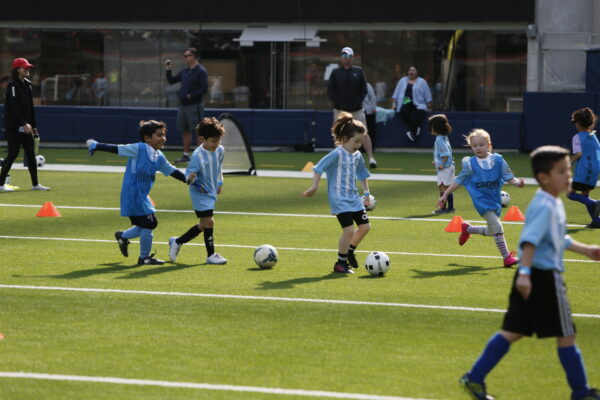Being Soccer Fit – Dispelling The Youth Soccer Conditioning Myths
This post is designed to break down the myths and the facts behind what soccer is in relation to conditioning and how to get soccer fit!
3 Myths of Conditioning and Fitness In Soccer & Being Soccer Fit
What is Being Soccer Fit?
Raymond Verheijen – Ex-Barcelona, Chelsea & Manchester City
“Fitness in soccer is two things: playing with a higher tempo, which means more actions per minute; and playing for longer, which means maintaining the tempo for beyond game minutes.”

MYTH #1 – RUNNING LAPS
Running laps will not support your child’s endurance for soccer.
Whilst the idea of being able to run for a long time is understandable, with the nature of soccer needing rapid, intense & varied heart rate responses, running laps will do little to support this.
If not laps, what?
Small Sided Games – Valter Di Salvo – Ex- Real Madrid & Manchester United Fitness coach
“Youth soccer players need to develop their physical performance (maximal aerobic capacity & ability to repeated sprints), technical, & tactical abilities. Therefore, the use of 2 vs. 2 and 3 vs. 3 SSG seems to represent an ideal alternative to optimize simultaneously these components in youth soccer players.”

MYTH #2 – FITNESS WITHOUT A BALL
Raymond Verheijen (again) – Ex-Barcelona, Chelsea & Manchester City
“Fitness is not something you need to play football, it is something you develop by playing football…
At your club you only train three times each week so time is very valuable. If you are taking up to an hour each week for these movements you are losing an hour. At Chelsea where everything is already perfect, the specialist might add 1-2% but at the level where you only train 2-3 times each week there is no place for the specialist.
The football coach should use every minute to develop football, so do a warm up where they immediately have a ball, and increase their body temperatures by dribbling.”
Developing Soccer Fitness
Alexandre Dellal – Ex-Olympique Lyon & OGC Nice Fitness Coach
“Compared to match-play, total distance covered per minute of play, high-intensity running activities (sprinting and high-intensity runs), total numbers of duels and lost ball possessions were significantly greater within SSGs (than Larger Sided Games) for all playing positions.”
More from Ryamond Verheijen
“If you want to train with a higher tempo, you play with less
players.
With 11v11 players make 2 actions per minute. If you want to overload that you play 7v7 where they make 4 actions per minute. Or you play 4v4 where they make 6 actions per minute.
So reducing the total number overloads the players and increases the demands upon them.
For the other component you just play for more minutes. So this week you might play 4×4 minutes of 6v6 and next week you play 4×4.5 minutes, then 4×5 minutes and so on.
By simply increasing the number of minutes you are training the ability to maintain the tempo for longer. What you see is that when
you define fitness in football action language, you will end up with football exercises from football coaches. If you call “fitness” more actions per minute, you will get a small sided game”

MYTH #3 – AGILITY WORK & LADDERS
Turner, A (2011) Defining, Developing & Measuring Agility
“Agility is defined as the ability to change direction in response to a sport-specific stimulus, incorporating physical, technical, perceptual and decision-making skills. Unless the athlete responds to a sport-specific stimulus”
We are limited for time when we practice, minimal hours to make an impact. That impact should be focused on the ball, the individual players and decisions making. When taught correctly and encouraged constantly, players in 1v1s will change direction and show “Agility” constantly whilst getting much needed time on and around the ball.

IN CONCLUSION
To sum it up, let’s clear up some soccer fitness myths that might confuse parents who want the best for their kids. First off, just running laps won’t help your child’s soccer skills. The game is all about quick moves and bursts of energy, so playing small-sided games is a better way to go.
Here’s another thing: fitness without a ball isn’t as helpful as it seems. Experts like Raymond Verheijen say that practicing with a ball is the real deal. Plus, when we talk about fitness, it’s about moving fast and keeping up the energy, which comes naturally when playing soccer.
Lastly, don’t worry too much about fancy agility drills or ladder exercises. What really matters is helping your child get better at changing direction during the game. This happens naturally when they play one-on-one with others and focus on their ball skills.
Remember, the key is to keep soccer practice fun and focused on the game itself. So, when you hear these myths, don’t sweat it. Stick to what really works: playing with a ball, practicing with others, and enjoying the game.





